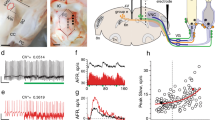Summary
-
1.
Neuronal discharges were recorded extracellularly in curarized frogs (Rana esculenta) with glassmicropipettes. Vestibular neurons, which were activated by ipsilateral horizontal angular acceleration and suppressed during deceleration (type 1) were found mainly in the medial part of the ventral vestibular nucleus.
-
2.
In contrast to type 1 vestibular neuron of the cat, this type of neuron in the frog was not suppressed, but facilitated by electrical stimulation of the contralateral vestibular nerve, irrespective of stimulus intensity. In most cases the facilitation was subthreshold for producing full action potentials when single stimulation was applied.
-
3.
Single shocks applied to the contralateral vestibular nerve evoked small negative field potentials (maximum peak amplitude, 300 μV) in the vestibular nucleus. The threshold for the potential was 2.5–3.0 times threshold for the field potential recorded in the vestibular nucleus on the stimulated side. The latency ranged from 5.0 to 8.0 msec.
-
4.
Intracellular recordings were obtained from the neurons in the medial part of the ventral vestibular nucleus. These neurons exhibited monosynaptic EPSP in response to ipsilateral vestibular nerve stimulation. Following electrical stimulation of the contralateral vestibular nerve polysynaptic EPSPs were found with latencies between 5.0 and 10.0 msec and no IPSPs were detected.
-
5.
The EPSPs induced by single supramaximal shocks to the contralateral vestibular nerve were in most cases not large enough to evoke full action potentials. In more than half of the cells recorded from, partial spikes were superimposed on the EPSPs.
-
6.
In the vestibular neurons which send axons to the peripheral receptor organs, EPSPs were induced by stimulation of the contralateral vestibular nerve. There were no highly significant differences between the time courses of these EPSPs and those described in 4.
Similar content being viewed by others
References
Baker, R.G., Mano, N., Shimazu, H.: Postsynaptic potentials in abduoens motoneurons induced by vestibular stimulation. Brain Res. 15, 577–580 (1969)
Brookhart, J.M., Fadiga, E.: Potential fields initiated during monosynaptic activation of frog motoneurones. J. Physiol. (Lond.) 150, 633–655 (1960)
Burlet, H.M. de: Zur vergleichenden Anatomie der Labyrinthinnervation. J. comp. Neurol. 47, 155–169 (1929)
Cohen, B., Suzuki, J., Bender, M.B.: Eye movements from semicircular canal nerve stimulation in the cat. Ann. Otol. (St. Louis) 73, 153–169 (1964)
Duensing, F., Schaefer, K.P.: Die Aktivität einzelner Neurone im Bereich der Vestibulariskerne bei Horizontalbeschleunigungen unter besonderer Berücksichtigung des vestibulären Nystagmus. Arch. Psychiat. Nervenkr. 198, 225–252 (1958)
Goldberg, J.M., Fernandez, C.: Physiology of peripheral neurons innervating semicircular canals of the squirrel monkey. I. Resting discharge and response to constant angular accelerations. J. Neurophysiol. 34, 635–660 (1971)
Groen, J.J., Löwenstein, O., Vendrik, A.J.H.: The mechanical analysis of the responses from the end-organs of the horizontal semicircular canal in the isolated elasmobranch labyrinth. J. Physiol. (Lond.) 117, 329–346 (1952)
Grofová, I., Corvaja, N.: Commissural projection from the nuclei of termination of the VIIIth cranial nerve in the toad. Brain Res. 42, 189–195 (1972)
Highstein, S.M., Ito, M., Tsuchiya, T.: Synaptic linkage in the vestibulo-ocular reflex pathway of rabbit. Exp. Brain Res. 13, 306–326 (1971)
Kappers, C.U.A., Huber, G.C., Crosby, E.C.: The lateral line and acoustic systems. In: The comparative anatomy of the nervous system of vertebrates, including man, pp. 433–503. New York: The Macmillan Company 1936
Kasahara, M., Mano, N., Oshima, T., Ozawa, S., Shimazu, H.: Contralateral short latency inhibition of central vestibular neurons in the horizontal canal system. Brain Res. 8, 376–378 (1968)
Kasahara, M., Uchino, Y.: Selective mode of commissural inhibition induced by semicircular canal afferents on secondary vestibular neurons in the cat. Brain Res. 34, 366–369 (1971)
Llinás, R., Precht, W.: The inhibitory vestibular efferent system and its relation to the cerebellum in the frog. Exp. Brain Res. 9, 16–29 (1969)
Löwenstein, O., Sand, A.: The mechanism of the semicircular canal. A study of the responses of single fiber preparations to angular accelerations and rotation at constant speed. Proc. roy. Soc. B. 129, 256–275 (1940)
Mano, N., Oshima, T., Shimazu, H.: Inhibitory commissural fibers interconnecting the bilateral vestibular nuclei. Brain Res. 8, 378–382 (1968)
Precht, W., Baker, R.G.: Synaptic organization of the vestibulo-trochlear pathway. Exp. Brain Res. 14, 158–184 (1972)
Precht, W., Llinás, R., Clarke, M.: Physiological responses of frog vestibular fibers to horizontal angular rotation. Exp. Brain Res. 13, 378–407 (1971)
Precht, W., Richter, A., Ozawa, S., Shimazu, H.: Intracellular study of frog's vestibular neurons in relation to the labyrinth and spinal cord. Exp. Brain Res. 19, 377–393 (1974)
Shimazu, H., Precht, W.: Tonic and kinetic responses of cat's vestibular neurons to horizontal angular acceleration. J. Neurophysiol. 28, 991–1013 (1965)
Shimazu, H., Precht, W.: Inhibition of central vestibular neurons from the contralateral labyrinth and its mediating pathway. J. Neurophysiol. 29, 467–492 (1966)
Steinhausen, W.: Über den Nachweis der Bewegung der Cupula in der intakten Bogengangsampulle des Labyrinthes bei der natürlichen rotatorischen und calorischen Reizung. Pflügers Arch. ges. Physiol. 228, 322–328 (1931)
Steinhausen, W.: Über die Beobachtung der Cupula in den Bogengangsampullen des Labyrinthes des lebenden Hechts. Pflügers Arch. ges. Physiol. 232, 500–512 (1933)
Szentágothai, J.: The elementary vestibulo-ocular reflex arc. J. Neurophysiol. 13, 395–407 (1950)
Thomas, R.C., Wilson, V.J.: Precise localization of Renshaw cells with a new marking technique. Nature (Lond.) 206, 211–213 (1965)
Van Egmond, A.A.J., Groen, J.J., Jonkees, L.B.W.: The mechanics of the semicircular canal. J. Physiol. (Lond.) 110, 1–17 (1949)
Author information
Authors and Affiliations
Rights and permissions
About this article
Cite this article
Ozawa, S., Precht, W. & Shimazu, H. Crossed effects on central vestibular neurons in the horizontal canal system of the frog. Exp Brain Res 19, 394–405 (1974). https://doi.org/10.1007/BF00234463
Received:
Issue Date:
DOI: https://doi.org/10.1007/BF00234463




